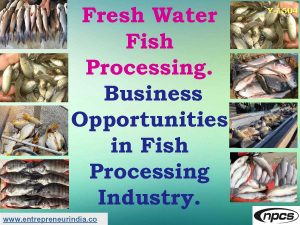
Fresh water fish processing. Business Opportunities in fish processing Industry.
The term fish processing refers to the processes associated with fish and fish products between the time fish are caught or harvested, and the time the final product is delivered to the customer. Although the term refers specifically to fish, in practice it is extended to cover any aquatic organisms harvested for commercial purposes, whether caught in wild fisheries or harvested from aquaculture or fish farming.
Larger fish processing companies often operate their own fishing fleets or farming operations. The products of the fish industry are usually sold to grocery chains or to intermediaries. Fish are highly perishable. A central concern of fish processing is to prevent fish from deteriorating, and this remains an underlying concern during other processing operations.
Fish processing can be subdivided into fish handling, which is the preliminary processing of raw fish, and the manufacture of fish products. Another natural subdivision is into primary processing involved in the filleting and freezing of fresh fish for onward distribution to fresh fish retail and catering outlets, and the secondary processing that produces chilled, frozen and canned products for the retail and catering trades. There is evidence humans have been processing fish since the early Holocene. These days, fish processing is undertaken by artisan fishermen, on board fishing or fish processing vessels, and at fish processing plants.
The fish processing industry is important in the attainment of self-sufficiency in fish. Fish processing prevents wastage and prolong the shell-life of highly perishable fish. It also increases the dollar reserve of the country through exportation.
Market Outlook
Indian fisheries and aquaculture is an important sector of food production providing nutritional security, besides livelihood support and gainful employment to more than 14 million people, and contributing to agricultural exports. With diverse resources ranging from deep seas to lakes in the mountains and more than 10% of the global biodiversity in terms of fish and shellfish species, the country has shown continuous and sustained increments in fish production since independence. The total fish production during 2017-18 is estimated to be 12.60 million metric tons, of which nearly 65% is from inland sector and about 50% of the total production is from culture fisheries, and constitutes about 6.3% of the global fish production.
Increasing contributions from inland sector and further from aquaculture have been significant over the years. With high growth rates More than 50 different types of fish and shellfish products are being exported to 75 countries around the world. Fish and fish products have presently emerged as the largest group in agricultural exports from India,
The Indian fish market was worth INR 1,110 Billion in 2018. The market is further projected to reach INR 1,998 Billion by 2024, growing at a CAGR of 10.2% during 2019-2024. For nearly 6% of the global fish production, India today represents one of the largest producers of fish in the world. Both, domestic consumption as well as export of fishes have witnessed a strong growth in India over the last few years. The per capita consumption of fish has also shown a continuous growth over the last several years. A number of factors are currently driving the consumption of fish in India.
The market for health and wellness foods in India is currently exhibiting strong growth. As previously discussed, fishes are perceived as a healthy food containing high levels of digestible protein, Increasing awareness of fish as a food associated with health and wellness is expected to create a positive impact on its consumption in the coming years.
Operations of the fish/seafood processing industry include gathering, segregating, cutting, and packaging of seafood into ready-to-eat containers for retail purposes. Few companies operating in this industry are also engaged in providing fresh seafood to restaurants. The seafood processing industry acts as a link between retail customers and the fishermen, providing the later with a source of living. Whole port town economies are dependent on the seafood processing industry for their income.
However, rise in raw material prices and strict environmental regulations protecting fish species is expected to impede the market growth. The emerging markets of India, China, and Brazil provide numerous growth opportunities for fish processing market expansion. Major drivers identified driving the market of fish processing are the continuous rise in demand of seafood, changing consumers dietary habits and consumers demand for differentiated and value-added seafood products. Fish processing industries is also accessible by seafood producers and so they can control the final product, quality and hygiene. Increasing fish feed is also a major driver identified driving growth for the global fish processing market. Development and distribution channel with improvements in technology in packaging, processing and storage of fish is also a factor identified driving the market growth.
Key players
Amalgam Enterprises (India), American Abalone Farms (USA), Austevoll Seafood ASA (Norway), Bakkafrost (Denmark), Blue Ridge Aquaculture Inc. (USA), Camanchaca (Chile), Cargill, Incorporated (USA), Cermaq ASA (Norway), Charoen Pokphand Foods Public Company Limited (Thailand), Cooke Aquaculture (Canada), Dainichi Corporation (Japan), Dongwon Industries Co. (South Korea), Empresas AquaChile S.A. (Chile), Farmocean International A.B. (Sweden), Grieg Seafood ASA (Norway), Kyokuyo Co. Ltd. (Japan), Marine Harvest ASA (Norway), Marine Harvest Canada (Canada), Maruha Nichiro Corporation (Japan), Multiexport Foods (Chile), Nireus S.A. (Greece), Nippon Suisan Kaisha Ltd. (Japan), Norway Royal Salmon ASA (Norway), Nutreco N.V. (The Netherlands), Royal Greenland A/S (Greenland), SalMar ASA (Norway), Sea Watch International Ltd. (USA), Selonda Aquaculture S.A. (Greece), Stolt Sea Farm S.A. (Norway), Surapon Foods Public Company Limited (Thailand), Tassal Group Ltd. (Australia), Taylor Shellfish Inc. (USA), Thai Union Group PLC (Thailand), Trident Seafoods (USA), TriMarine International (USA), Tongwei Group Co. Ltd. (China), Unima Group (France), Zhanjiang Guolian Aquatic Products Co. Ltd. (China), Aquaculture Technology/Equipment Providers, AKVA Group (Norway), AquaBounty Technologies Inc. (USA), Aquacare Environment Inc. (USA)
See more